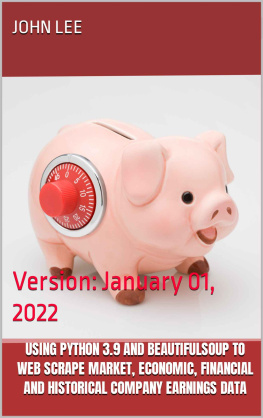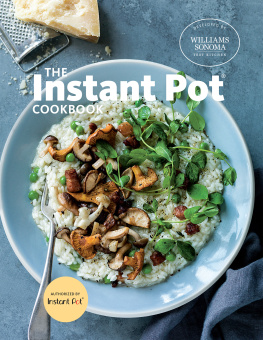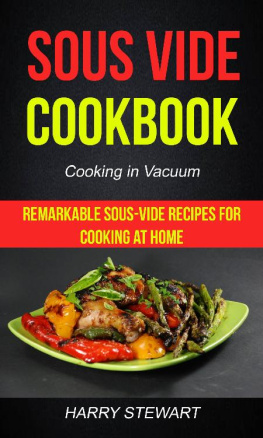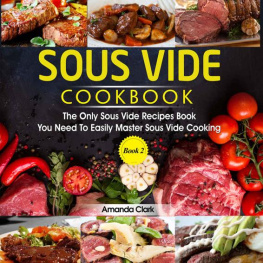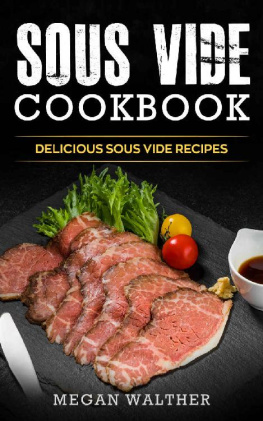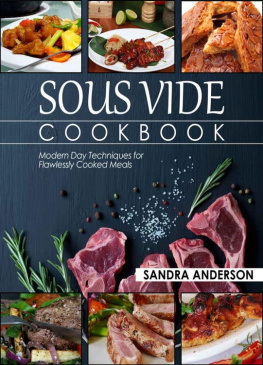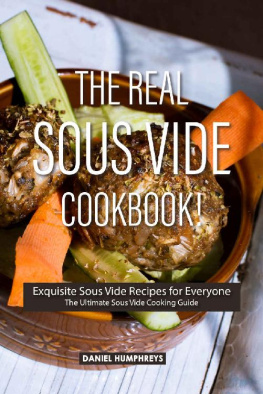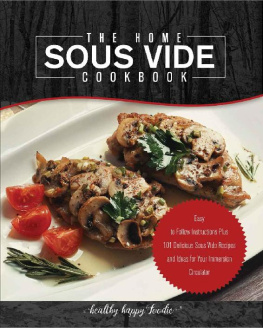Contents
Guide
Photographs
John Lee
sous vide
COOKBOOK
THE
Contents
Pork Chops with JalapeoAgave
Nectar Salsa,
Honey-Dijon Salmon,
UNDERSTANDING SOUS VIDE
The French term
sous vide
, literally under vacuum, is used to describe
food that is vacuum sealed in plastic for cooking in a temperature-controlled
water bath. Originally used in scientific laboratories because of its precision,
sous vide has since become the secret weapon of Michelin-starred chefs
who appreciate the unprecedented control it affords in the kitchen. Nowadays,
cooking sous vide boasts a growing and enthusiastic following among chefs
and home cooks alike.
The machine that makes this precision possible is an immersion circulator,
a device that both heats and then holds water at an exact temperature
and continuously circulates it. It allows foods sealed in airtight bags to
cook for longer times at lower temperatures than by conventional methods,
resulting in perfectly cooked, intensely flavorful meats, fish, vegetables,
eggs, and more. Steaks are especially tender and have a richer, meatier
flavor; custards emerge flawlessly silken; and mashed potatoes, because
they are not cooked in water, turn out creamier and more luscious. Sous vide
also makes conventionally long-cooked dishes like short ribs an overnight
proposition: put them in to cook on Tuesday evening and Wednesdays
dinner will be done when its time to set the table.
We love that sous vide frees you from standing at the stove and from
tinkering with the temperature. Its a boon to busy families, too: dinner can
be put on to cook just before the kids are dropped off at school and be ready
to eat at the end of the day. Easy to use, an immersion circulator makes
a wonderful gift for newlyweds or just-launched college grads, inspiring
confidence in novice cooks and encouraging experimentation in more
seasoned hands. The steady, low temperatures of sous vide cooking make
it easy to put together easy, no-stress meals without fear of overcooking.
And tech-savvy cooks will appreciate that some models are WiFi enabled,
allowing for remote cooking: just tap the app on your phone to start cooking
your meal while youre sitting at your desk or walking the dog.
Cooking sous vide is remarkably simple: Put the immersion
circulator in a water bath, attach the device to the side of the
water container, set the temperature, seal the food in a bag,
wait until the water reaches temperature, lower the bag into the
water, set the time, and walk away. (To make sure the bag stays
submerged and to ease its removal, attach the top of it to the side
of the container using a binder clip or dedicated sous vide clip.)
At the end of the cooking time, the bag can remain immersed in
the water for an extended period without the food overcooking.
TOOLS & TECHNIQUES
Cooking temperature
is precisely controlled,
so food never overcooks.
Food prepared sous vide
retains all of its nutrients
and allows for cooking
with less fat.
THE IMMERSION CIRCULATOR
heats
and then holds the water at a precise
temperature while keeping it in constant
motion. It can be used in any straight-
sided container, from a stockpot to a
heat-resistant plastic bin to a saucepan
for small bags. The container needs
only to have enough room and stability
to hold the immersion circulator, the bag
or bags, and sufficient water to freely
circulate around the bag(s).
COOKING SOUS VIDE
works with
both specialized vacuum bags and
a dedicated vacuum sealer (pictured
below) and, for some recipes, with
locktop plastic freezer bags that
are sealed using a water immersion
and air displacement technique.
Review each recipe for the method
best suited to its ingredients. For a
simple explanation of both methods,
see .
Many immersion circulators
let you know when the food
is ready, then keep it warm
until you're ready to eat.
A vacuum sealer removes
air from specialized plastic
pouches, ensuring food is
enclosed with both an airtight
and watertight seal.
Vacuum Seal vs. Water Immersion
A vacuum sealer delivers an airtight
seal on specialized vacuum bags,
making them capable of withstanding
high temperatures and long cooking
times. The airless environment created
by vacuum sealing helps to infuse foods
with the flavors of herbs, spices, garlic,
and other aromatics. Some vacuum
sealers can be set to remove a specific
percentage of air from a bag, a feature
that is particularly handy when working
with delicate ingredients that can be
crushed by extreme pressure. A Moist
setting on some models guarantees
a secure seal on juicy or marinated
foods. A double seal (seal once, move
the bag slightly, then seal again) is
another way to ensure a good seal
on wet ingredients.
Cooking sous vide is also possible
without a vacuum sealer for some
recipes. A water immersion and air
displacement method produces an
airtight seal especially suited to
heartier or quickly cooking foods. To
seal a bag using this method, place the
ingredients in a locktop plastic freezer
bag, arranging them in a single layer,
and seal the bag closed except for a
small opening at one corner. Holding
the bag near the opening, slowly lower
it into the water, leaving only the seal
exposed. The barometric pressure
COOKING SOUS VIDE
created by the water will force out
the air, creating a substantial vacuum.
Seal the opening securely closed
and youre ready to cook. (Be sure
to use a locktop bag, not one with
a sliding closure, which does not
allow a complete seal.)
Cooking Times & Sous Vide
The precise temperatures of sous
vide make it nearly impossible to
overcook a dish. Most recipes in this
book have a wide cooking window. For
example, Chicken Tacos with Mexican
Corn on the Cob () calls for
cooking the chicken for 24 hours
at 165F. At any point after the first
2 hours and up to 4 hours, the chicken
will remain perfectly cooked, with
the internal temperature fixed at
165F. Beyond 4 hours, the texture
of the chicken will begin to deteriorate.
With recipes such as steak, be sure
to select the temperature for the
doneness you prefer. See individual
recipes for temperatures.
Completing the Process
Although steaks, chops, and burgers
will be perfectly cooked when they
emerge from the water bath, they will
still need a swift browning for flavor
and a crusty exterior. A minute or two
in a very hot frying pan will give them



